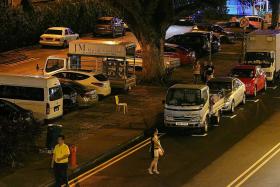Keong Saik's road from vice to nice
After a major makeover, it makes Lonely Planet's Asian must-see list, but some lament loss of old world-charm
As a teenager, Mr Lee Kok Leong would frequent Keong Saik Road with his father.
The younger Mr Lee, 56, a freelance researcher and writer, clarified with a laugh, when he said: "No, I didn't go there for the reason you are thinking of. I used to go to a printing firm there with my father, who was in the business."
CLICK ON THE POINTS IN THE IMAGE BELOW TO LEARN MORE ABOUT THE KEONG SAIK AREA
Once synonymous with vice, nothing in 1960s Keong Saik Road would have landed it on Lonely Planet's list of top 10 places to visit in Asia this year.
Praising the road's "heritage chic", colonial and art-deco buildings and "famed dining scene", the write-up in the famous travel guide - which was released earlier this month and also includes Sri Lanka's Hill Country and Malaysia's Melaka City - also lauded the area for being "the poster child for hip 'New Singapore'".
An influx of restaurants, watering holes and boutique hotels have quietly displaced the scores of brothels that for decades defined the area.

Before the 1950s, most of the brothels were tea houses and young women would play the Chinese lute and sing, much like geishas, Mr Lee said.
But when rubber prices skyrocketed after the Korean war, men became rich and started paying these girls for "additional services". Brothels flourished in the 1960s all the way to the 1980s, Mr Lee said.
Gang fights, gambling and opium abuse were also rife in the area, said Mr Tang Chew Fue, 53, the fourth-generation owner of Tong Ah Eating House in Keong Saik Road.

Mr Tang, who has worked there since he was 13, told TNP: "It was really colourful. Police cars and ambulances came often. It was a meeting place for gangsters. There were times we had to pull customers into our coffee shop and pull the metal shutters so we would be safe from the fights outside."
There were also grocery wholesalers, coffee shops and incense retailers there.
These businesses continued until the turn of the century, when the Urban Redevelopment Authority (URA) started putting up several rows of old shophouses for sale so they could be conserved and modified for commercial use.

The opening of Hotel 1929 in 2003 helped catalyse the gentrification of the area. The success of the boutique hotel, which was sold in 2013 for $35 million, led to the rejuvenation of The Royal Peacock Hotel, which was later sold to Hind Group in September 2011 for $42 million.
In 2012, the Hind Group opened Naumi Liora, a boutique hotel that has been praised for its "heritage chic" style.
Soon, Keong Saik Road became a tourist-friendly spot and culinary haven.
When a particular trade starts sprouting in an area, it attracts other businesses in a similar or complementary trade, Knight Frank's head of commercial sales Mary Sai said.
She told TNP: "When these businesses come together, there is always the collective appeal.People go there for one or two restaurants and probably will hop to another for drinks. As the tenants align themselves to the what customers want, naturally there will be a following."
When this happens, rents go up, said Ms Sai, who will not be surprised if the "old guard" give up their space for the right price.
That was how Tong Ah came to vacate its iconic pre-war shophouse of 75 years - a triangular building at the junction of Keong Saik Road and Teck Lim Road - four years ago.
Reportedly valued at $8 million in 2013, the space is now occupied by restaurant-bar Potato Head Folk, opened by Indonesian group PTT Family.
The decision shocked everyone then, and Mr Tang admitted there were frequent family disagreements over the deal. After six months of tiffs, Mr Tang decided to vacate the premises.
"Back then, I thought it was better to do it earlier so I have time to rebuild the business," he told TNP over a cup of kopi and kaya toast - Tong Ah's trademark.
Now, Tong Ah operates out of a nondescript space 50m across the street. In the evening, it turns into a zi char restaurant.
Business is finally back on track this year, but Mr Tang added quietly: "In the past, we were a close-knit community. Today, we still talk to regular customers, but it is just not the same any more."
SANITISED
Conversations at Tong Ah, which used to be loud and peppered with vulgarities, are now sanitised, thanks to the mix of the nearby office crowd and tourists.
Many things cannot be measured by economic value. Humans are great because we have that sentimental value.Freelance researcher and writer Lee Kok Leong, who conducts tours in the area
But hints of Keong Saik Road's old-world charm remain.
Some temples that have been gazetted for conservation sit between high-end restaurants such as the Asian-French Meta.
A lesser-known part of the area is where athletic associations like Sim San Loke Hup Athletics Associationis located.
Its flags continue to fly high atop a shophouse, which is also home to an active senior citizen centre and a coffee shop popular among the elderly.
A handful of brothels - their trade marked by distinctive fluorescent white boxes and red lettering - operate discreetly on one end of the road, accessible by a side staircase.
Mr Lee, who conducts tours in the area in hopes of preserving what is left of its heritage, said: "I don't know if brothels are acceptable. I hope they disappear. But I have to say the place has lost some colour.
"I don't quite like a street that is full of eating places. There are many of such places in Singapore, so if you want to build some unique flavour on Keong Saik Road, you have to think along the lines of traditional culture, such as getai or martial arts."

He warned against over-urbanisation - once something is taken away, it is hard to replicate the experience two decades later, he said.
"Many things cannot be measured by economic value. Humans are great because we have that sentimental value," he added.
Mr Loh Lik Peng, the man behind Hotel 1929, says it is a pity Keong Saik has gentrified so quickly. But the founder of hospitality group Unlisted Collection called it the "inevitable march of progress".
Consumers have contributed hugely to this. "Without the traffic and the money they bring, none of this would have happened," Mr Loh told TNP.
"You could argue it has been detrimental to the character of the area - if you really like its red-light past, that is, but at the same time, it has been a boon to local owners and businesses, who have seen increased traffic and activity."
He attributed the footfall to the "ready-made recipe" of forward-looking establishments housed in buildings that exude the old-world Singapore charm.
"You need both to have that magic the traveller is looking for," he said.
On the conservation front, the shophouses stand to gain too. Their increase in economic value means they are thoroughly restored and put to "good modern-day uses".
"Before this, the area had many rundown buildings that had not been properly looked after," Mr Loh pointed out.
What is critical for a gentrified like Keong Saik is managing the change - the displacement of original businesses, residents and users, said Dr Yeo Kang Shua, an architectural historian from the Singapore University of Technology and Design.
He said: "The question for us to ponder is how much change is enough?
"The newer businesses have brought about new users, locals and tourists alike, who enjoy the new amenities while soaking in the remaining ambience of the old street.
"Where is the balancing point? Where is the tipping point?"
Get The New Paper on your phone with the free TNP app. Download from the Apple App Store or Google Play Store now




